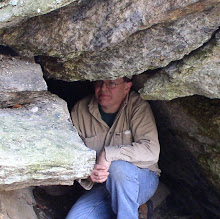A long and ugly winter is finally beginning to pass. So lets focus on what can be accomplished in the coming year. Usually, what was left behind from the previous year gets a priority, and that will be worked on as I venture into different sections of Massachusetts and Rhode Island.
But the first trip of this season was focused primarily on the Middlesex Fells, Cape Ann, and few stops in other areas of Essex County. So first stop was Bear Hill in The Fells where the historic Cheese Rock (so named by early Massachusetts Governor John Winthrop) was reportedly located. Generally, it is thought to be Bear Hill, or a ledge of that hill, overlooking to the north/northwest. However, one old book has a picture of it being an isolated boulder. That boulder was not uncovered on my trip, and I move on to the south, and the old Silver Mine.
It took a bit of doing to find the old Silver Mine site, but it allowed me a good look at the local woodlands. I also had a picture off an internet site showing a cave formation of some type in that general area. A stroke of good luck while wandering, took me down a side trail and to that cave formation. Very small, perhaps 3 feet deep on one side and 4.5 feet on the other, it was difficult to tell if natural or man made. No tools marks presented themselves, so perhaps just a weathered rock formation.

Turtle - or Pickerel - Rock at Spot Pond. Early 1900s postcard.
After finally visiting the Silver Mine (long ago capped by concrete), I moved on to an area of the Fells to the east. Old writings mention some of the Fells' largest boulders might be found here. This is an example where aerial photography helped plot my course. Several fine examples of erratics were located, with at least one matching an old Magic Lantern Slide in my collection: the Multiform Boulder. My time in Fells ended with a trip up around Pickerel (aka: Turtle) Rock before heading off to settle in to Gloucester.
The multiform boulder @ The Fells
Pickerel - or Turtle - Rock. Spot Pond in the Middlesex Fells.
The next day I continued on from a previous year's trip, with a more in-depth investigation into large boulders around one of the local reservoirs. It also gave me the opportunity to cross over that reservoir and examine close-up, Cave Rock, first seen last year. This was a huge rock, sitting on a steep shore, with the illusion of a passage beneath. No real passage here as it was a few feet under an overhanging edge with about a half dozen small pieces of broken rock forming a crude side wall. The day was finished out with a quick jaunt on a small section of the Old Rockport Road. Still keeping my eyes open for the Old Man of Joppa but I fear him lost.
Big boulder in the Gloucester woods.
The third day brought me once again to the shores of the Atlantic at Pigeon Cove. Over the Winter a small stash of old photography surfaced depicting sites in the area. One was of The Great Chasm (aka: Chapin's Gully), another of Dianah's Baths, and still another of Dick's Dream. What ended up being most curious (maybe not) was the Dick's Dream photo did not match anything at the previous know location. Also, on old maps of the area, I see Dick's mentioned in two different locations and a different location for Diana's Baths (different spelling) that what is in the photo. Once again, I am reminded "history" is not absolute. The day was finished up in the vicinity of Pigeon Hill where once again I looked for Boiling Spring (nothing!) and took a friend to Profile Rock and Rowe's Tomb.
Dianah's Baths as pictured circa 1870. Singers/Pulpit Rock in background.
My first goal on the fourth day was to locate a possible second entry point to a moraine in Peabody. I was somewhat successful, but entrance would have to be made through a housing complex and that entrance was well populated at the time with maintenance/landscape workers. However, I could see one of the more splendid examples of perched boulders in that area, just outside the perimeter of the lawn, and inside the edge of the woods.
The likely Shoemaker Rock.
I wanted to do some reconnaissance of the Nahant area for possible kayaking adventure around its shoreline. The conclusion here is, it might be somewhat of a logistical night to pull off. I managed to eke out a tiny exploration (by foot) on a section of Nahant's shore, where one old writing mentions a possible cave. Nothing seen by me on this visit. Driving back inland, I stopped by to check access - and visit - the Pirates Glen. Next stop, I found a huge boulder that is the likely Shoemaker Rock I've been looking for many years. Before pulling out of the area, I tried to negotiate a massive apartment complex to find a large boulder in the nearby woods seen on aerial imagery. No luck this time around.
Pirates Glen as depicted on an early 1900s postcard.
My final day was rained on. I set course for home hoping a break in the precipitation would allow me to get out again. Alas, it was not to be!













